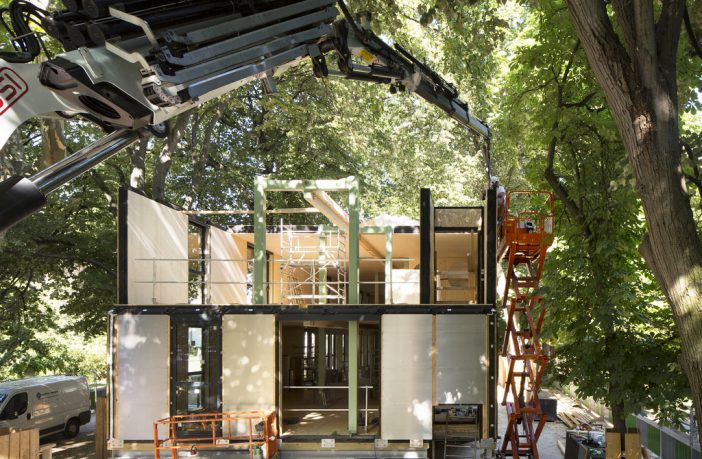The concept of Design for Disassembly (DfD for short) gained increasing traction in recent years, as it addresses the growing concern around the high consumption of resources and low recycling rate within the construction industry. The following article details on the method and features guidelines for a design process that facilitates the dismantlement of future buildings, with the scope of providing a better understanding of this principle within the broader framework of the current practice and circular economy.
What is Design to Disassembly?

By definition, Design for Disassembly is the design of buildings to facilitate future changes and dismantlement (in part or whole) for recovery of systems, components and materials, thus ensuring the building can be recycled as efficiently as possible at the end of its lifespan. The strategy builds on an increasing acknowledgment of the fact that the majority of the built environment has a limited lifespan and that every building represents a depository of resources, which, rather than ending up in a landfill, should find their way back into the “reduce, reuse, recycle” loop. As such, DfD involves understanding the structure’s complete life-cycle and making provisions for the reuse of its parts, in order to reduce both the consumption of resources and pollution.
First defined in the 1990s, the concept is relatively new, therefore few projects have been designed with disassembly in mind, and even fewer have tested out the outcome of the strategy. Nonetheless, this pursuit is now making its way into mainstream practice, one such example being the new London Plan, which will require planning applications to demonstrate how the building components can be disassembled and reused. Furthermore, both the EU project Buildings as Material Banks (BAMB) and EPA (the United States Environmental Protection Agency) have drawn out guidelines for this design process, while several sustainability certifications award points for the design for deconstruction.
Opportunities and Challenges

The construction industry is the world’s largest consumer of raw materials, and most of them never return to the material loop. Incorporating the DfD strategy into the architectural process would reduce the embodied energy and carbon emissions of the construction sector, as it would significantly curtail the consumption of first-use materials. Nonetheless, the DfD process is not without its challenges. The lack of regulation regarding recycled materials and the uncertainty around the quality and quantity of used materials are still disincentives to the DfD method. Another significant challenge, for the time being, is the cost and speed of the process, as demolition is considered cheaper and faster than taking a construction apart piece by piece. However, research by EPA demonstrated that deconstruction could be cost-competitive with demolition if there are sufficient recoverable materials with a good market value to offset the higher labour costs.
Design Principles

The DfD process requires a significant amount of planning early on in the design phase, and there are strategies and principles to consider, to ensure the architectural object holds value once it has reached its end of life. The following are a few general guidelines to follow when designing for disassembly.
Planning the Deconstruction

DfD requires generating a detailed deconstruction plan, including instructions for the disassembly of elements, as well as a review of the building components and materials and how they should be reused, recycled, or reclaimed. Rotor Deconstruction, a Belgian pioneer in the field of recovered building components disassembles, conditions and sells materials, while Arup, in the research The Circular Economy in the Built Environment, foresees the use of cloud-based BIM models to record and track materials and components through their life-cycle, as well as a standard in using full life-cycle contracts from design to disassembly.
Assessing Materials

Design for Disassembly requires extensive research into construction materials for selecting the ones that are non-toxic, of high quality (to withstand assembly and disassembly) and have good recycling potential. The process of choosing materials within this design method revolves around questions such as: what happens to a component at the end of its life? How can it be reused, or could it be returned to the supplier? There is software that could help make this evaluation, by generating Life Cycle Assessment (LCA) of specific input materials.
Choosing Connection Details

One fundamental principle of DfD is creating accessible connections and choosing the appropriate joinery in order to ease dismantlement and avoid the use of heavy equipment, or too many tools. The focus should be on mechanical joinery, using bolted, screwed or nailed connections, as opposed to non-removable, chemical ones such as binders, sealers, glues or welding, which would make the material difficult to separate and recycle.
Designing for Adaptability

Although Design for Disassembly focuses on the life end of a building, the method seems to be an excellent strategy for extending a construction’s use. Thus, separating different building systems and making their replacement less disruptive to the overall building creates a greater opportunity for future renovations. This could be the case of MEP systems, whose lifespan is much shorter than that of other systems within the building and where DfD could make the selective removal of specific elements much easier, resulting in less waste. Favouring modularity and standardization in the design process of assemblies and components also facilitates reuse.

For the time being, designing for disassembly is not an easy endeavour, bringing an added layer of responsibility and requiring a significant effort from all parties involved in the construction process, architects included. Less encouraging is the uncertainty regarding whether the few examples of projects designed with this process in mind will be deconstructed and reused as to the architects’ intent. Since DfD is still in its infancy, end-results are yet to be seen, and the conclusions lie decades in the future. Nonetheless, as the construction industry engulfs an excessive amount of resources and first –use materials each year, no effort should be spared, and all strategies should be considered when it comes to reducing waste.
Author: Andreea Cutieru
References
- Brad Guy and Nicholas Ciarimboli, Design for Disassembly in the built environment: a guide to closed-loop design and building, 2005
- The American Institute of Architects, Buildings that last: design for adaptability, deconstruction and reuse
- Akinade, O.O., et al. Design for Deconstruction (DfD): Critical success factors for diverting end-of-life waste from landfills. Waste Management, 2016, available here.
This article was first published in Arch Daily and is republished with permission.












